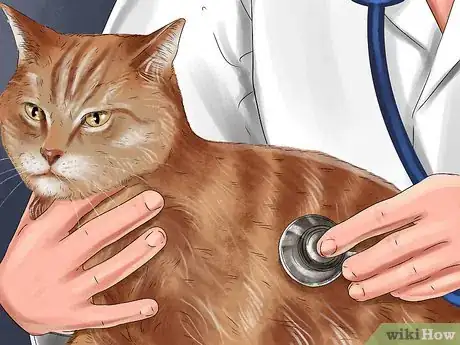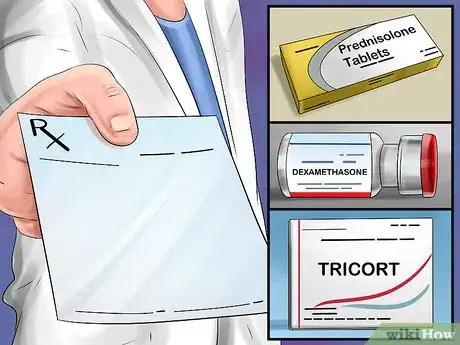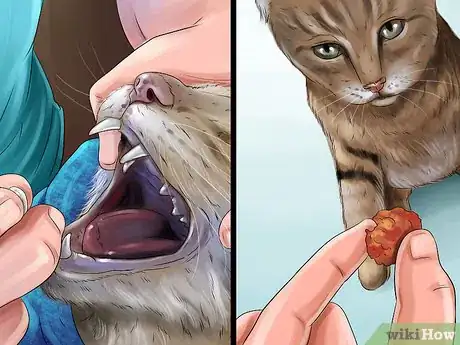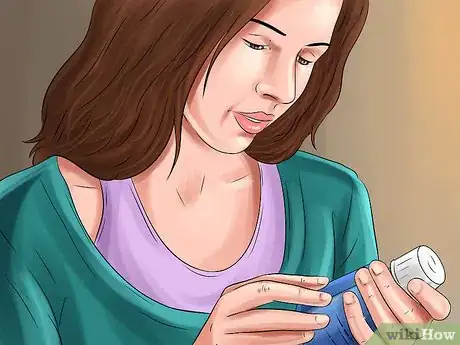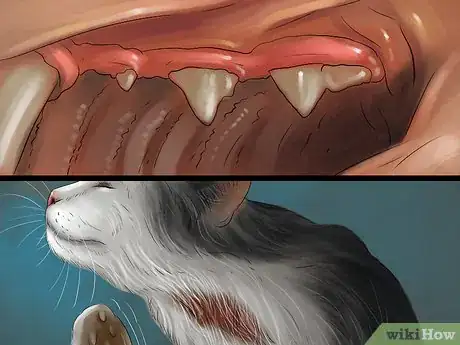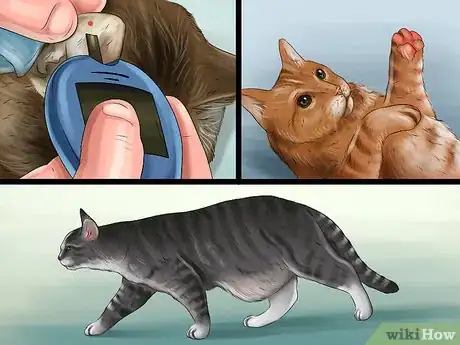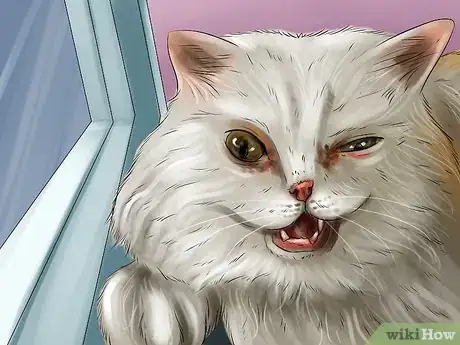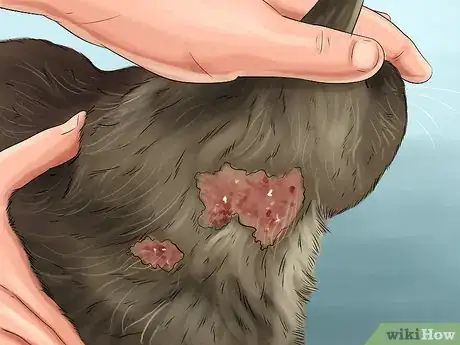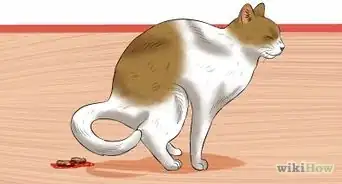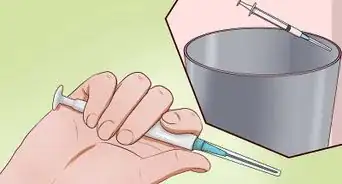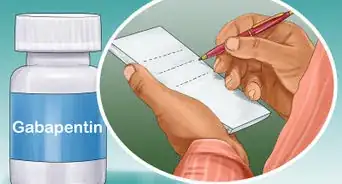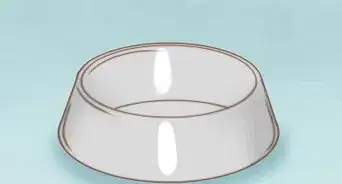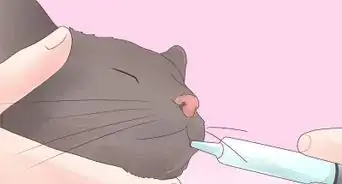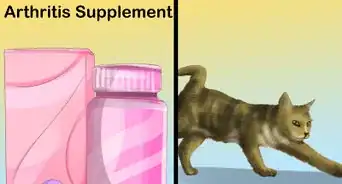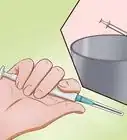This article was co-authored by Pippa Elliott, MRCVS. Dr. Elliott, BVMS, MRCVS is a veterinarian with over 30 years of experience in veterinary surgery and companion animal practice. She graduated from the University of Glasgow in 1987 with a degree in veterinary medicine and surgery. She has worked at the same animal clinic in her hometown for over 20 years.
This article has been viewed 25,758 times.
Steroids are a common veterinary treatment for inflammation in cats. They suppress the immune system, which can decrease inflammation and pain. However, by suppressing the immune system, you can create other risks to your cat's health. If you think your cat has inflammation that needs treatment, you should have it assessed by a veterinarian and then administer steroids as prescribed.[1]
Steps
Getting Veterinary Treatment for Inflammation
-
1Have your cat seen by a veterinarian. If your cat has any of the symptoms of inflammatory disease, you should have it seen by a veterinarian. Tell the veterinarian about your cat's symptoms and allow them to do a thorough examination of your cat. They will give you a diagnosis and they will discuss treatment options.
- If your veterinarian suspects that your cat has inflammation that needs treatment, they may suggest a round of steroids to reduce it.
-
2Get a prescription for steroids. Once you and your veterinarian agree on a treatment plan for your cat, they will prescribe your cat steroids or they will inject steroids in the cat themselves. The steroids that are most often prescribed for cats are in pill form and include:
- Prednisolone
- Dexamethasone
- Triamcinolone
- Budesonide
Advertisement -
3Give your cat the medication. Getting a cat to take medication can be difficult. You can try to hide it in their food and hope that they will eat it when they are eating. If that doesn't work, you may need to restrain the cat and force it to swallow the medication.
- Always give steroids with food or after a meal. If you give a cat steroids on an empty stomach, it could develop ulcers.
- Restraint may be uncomfortable for the cat but it should never injure the cat or cause pain. Using a towel to wrap up the cat is usually the easiest, and least traumatic, way of restraining a cat.
- If your cat is on other medications, talk to your vet before giving it steroids. Steroids could interact with other medications, such as meloxicam, and cause dangerous side effects.
Managing Treatment
-
1Follow the directions when giving the medication. When you give your cat medication you should be sure to read and follow the directions included. This will include how often the medication should be given, whether is should be given with food, what the daily dosage should be, and how long the medication should be given.[2]
- If you are unsure about any of the directions on the packaging, as your veterinarian to clarify.
- It is very important to give your cat the right amount of medication for the right amount of time. Giving a cat too many steroids can cause health problems.
-
2Treat underlying conditions. While steroids can help to alleviate inflammation temporarily, they will not cure underlying conditions that cause inflammation. Because of this, you should put some effort into figuring out what is causing your cat's inflammation.[3]
- Some common causes of inflammation in cats include osteoarthritis, soft tissue injuries, allergies, and gingivitis. These medical issues are typically diagnosed and treated by a veterinarian after the general symptoms of pain and discomfort or skin irritation are spotted by a cat's owner.
- Because long-term steroid use can cause a variety of health problems, finding the cause of your cat's inflammation, and treating that, will help your cat avoid these problems in addition to solving the underlying problem.
-
3Manage short-term side effects. Steroids can cause a variety side effects that can negatively impact your cat's life. If your cat has any of these short-term side effects you should discuss solutions with your veterinarian:[4]
- Increased hunger
- Increased thirst
- Increased urination
- Lethargy
- Gastrointestinal problems
- Hair loss
-
4Assess any developing long-term side effects. It is important to keep an eye out for the development of long-term side effects due to steroid treatments. If your cat begins to develop any of these problems, you should seek out veterinary care right away:[5]
- A pot belly (which often signals the presence of Cushing’s disease)
- Blood clots
- Diabetes
- Pancreatitis
- Secondary infections
Identifying Inflammation
-
1Identify signs of chronic pain. Inflammation in the bones and joints that goes untreated can often lead to chronic pain. Your cat may become listless, unable to move easily, sensitive to touch, or ill-tempered if it is dealing with chronic pain. If your cat has these symptoms, you should have it looked at by a veterinarian.
- Steroids can reduce the inflammation associated with several conditions, including osteoarthritis and soft tissue injuries. This may reduce the cat's discomfort.
- If the cat is still in pain, your vet may prescribe a separate painkiller for your cat. Make sure that this painkiller is safe to use with steroids.
-
2Pay attention to signs of other inflammatory diseases. There are a variety of other inflammatory diseases that your veterinarian may want to treat with steroids. For example, the symptoms of inflammatory bowel disease are commonly treated with steroids. Signs that your cat has inflammatory bowel disease include:
- Vomiting
- Diarrhea
- Lethargy
- Weight loss
-
3Look for areas of external inflammation. In addition to treating internal inflammation, steroids can help with areas of inflammation on the outside of your cat's body. Inflammation of the skin, called dermatitis, inflammation of the eyes, and inflammation of the gums can all usually be treated with steroids.[6]
- Allergies are a common cause of inflammation on the outside of the body. Steroids can minimize this type of inflammation, although they do not solve the problem permanently.
References
- ↑ http://www.catwatchnewsletter.com/issues/21_1/features/Long-term-Steroids-for-Cats_141594-1.html
- ↑ http://www.catster.com/lifestyle/prednisone-for-cats
- ↑ http://www.catwatchnewsletter.com/issues/21_1/features/Long-term-Steroids-for-Cats_141594-1.html
- ↑ http://www.catwatchnewsletter.com/issues/21_1/features/Long-term-Steroids-for-Cats_141594-1.html
- ↑ http://www.catwatchnewsletter.com/issues/21_1/features/Long-term-Steroids-for-Cats_141594-1.html
- ↑ http://www.catwatchnewsletter.com/issues/21_1/features/Long-term-Steroids-for-Cats_141594-1.html
About This Article
If your cat has inflammation, take it to the vet, who will either give you a prescription for steroids or inject them in the cat themselves. While it can be difficult to get a cat to take medication, there are tricks you can use, such as hiding the steroid in its food. However, if that doesn't work, you may need to wrap your cat in a towel to restrain it, then force it to swallow the medication. Whatever you end up doing, make sure to only give your cat steroids during or after meals, or it could develop an ulcer. For more advice from our Veterinarian co-author, such as how to manage any short-term side effects of steroids, read on!
